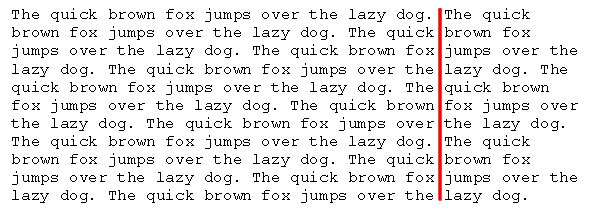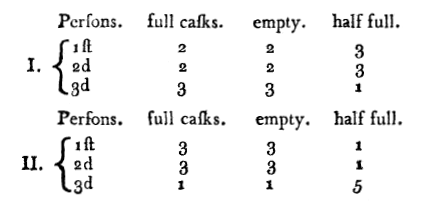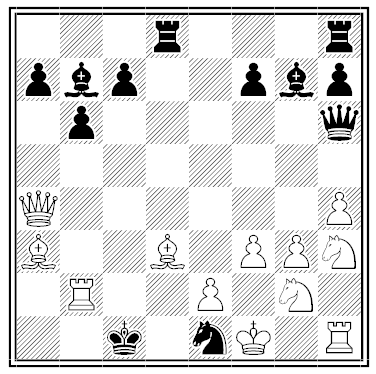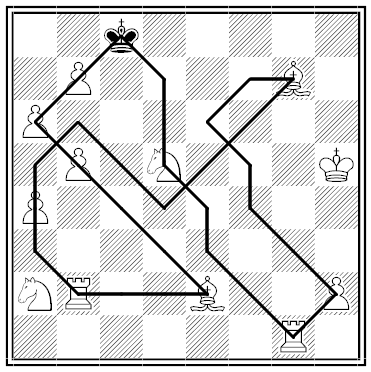A printer prints a sentence in a monospaced font. It inserts a space after the concluding period and then prints the same sentence again. It continues in this way until it has filled the page, running the sentences together into one long paragraph. The sentence is shorter than a full line, and no words are hyphenated. Prove that the finished page will always include a full column of blank spaces.
Puzzles
Straw Poll
A groaner from Clark Kinnaird’s Encyclopedia of Puzzles and Pastimes (1946):
“A farmer had 3 3/7 haystacks in one field and 5 4/9 haystacks in another field. He put them all together. How many did he have then?”
I’ll withhold the answer.
The Magic Dollar
This is a story of four brothers. Billy owed a dollar to Jerry. Jerry owed a dollar to Tommy, and Tommy owed a dollar to Billy. The three of them met one day at a family picnic. Being brothers and good friends, none wished to hound the other about his debt. Vincent, the fourth brother, arrived at the picnic with some beer. While he was busily unloading the truck, Billy walked over, unnoticed, and quietly asked Vincent for a loan of a dollar, which Vincent gladly gave to him. Billy then ambled over to Jerry and paid him the dollar he owed him; then Jerry paid Tommy the dollar he owed to him; Tommy then went over to Billy and paid him the dollar he owed him. Billy then walked back to Vincent and paid him back his dollar. All old debts were paid. Simple, isn’t it?
— Raymond F. Lausmann, Fun With Figures, 1965
The Magic Dice Cup

A tangram paradox from Sam Loyd’s Eighth Book of Tan (1903). Each of these cups was composed using the same seven geometric shapes. But the first cup is whole, and the others contain vacancies of different sizes.
“Of course it is a fallacy, a paradox, or an optical illusion, for you will say the feat is impossible!” But how is it done?
The Deliveryman’s Problem
A puzzle from L. Despiau’s Select Amusements in Philosophy and Mathematics, 1801:
Distribute among 3 persons 21 casks of wine, 7 of them full, 7 of them empty, and 7 of them half full, so that each of them shall have the same quantity of wine, and the same number of casks.
Recalling Yesterday
From P.M.H. Kendall and G.M. Thomas, Mathematical Puzzles for the Connoisseur, 1962:
I’ve just been reading Jules Verne’s Around the World in Eighty Days — you know, where Phileas Fogg lost a day on the way round. Our science master says that ships put it right nowadays by having a thing called a Universal Date Line in the Pacific. When you cross the line from East to West you put the calendar on a day; and when you cross it the other way you put the calendar back. What I want to know is, when Puck put a girdle round the Earth in forty minutes and presumably did the right thing on crossing the Date Line, why didn’t he get back on the day before he started — or the day after, according to which way round he went?
I asked the English master this and he got quite cross about it and said it was nothing to do with Shakespeare. But if you flew round the earth as quickly as Puck it would matter, wouldn’t it?
Wouldn’t it? Why doesn’t Puck lose a day?
Black and White
The Annual Liars
Two brothers are scrupulously truthful, with one exception: Each lies about his birthday on his birthday.
On New Year’s Eve you ask what their birthdays are. The first says “Yesterday” and the second says “Tomorrow.”
On New Year’s Day you ask again what their birthdays are. Again the first says “Yesterday” and the second says “Tomorrow.”
What are their birthdays?
A Chess Maze
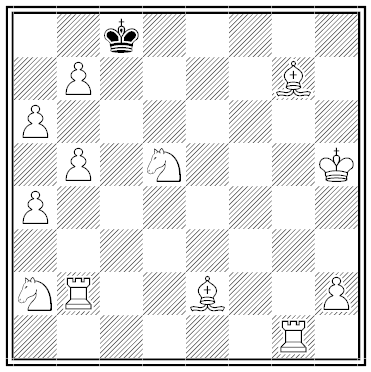
Harry L. Nelson offered this puzzle in the Journal of Recreational Mathematics in 1983. The black king’s favorite square is c8, but he finds it is under attack by a white pawn. In how few moves can he correct this problem and return to a peaceful c8? White never moves. The black king can capture white pieces, but he may not visit any square more than once and may not enter check.
A Thought Experiment
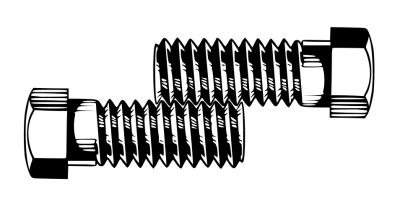
Suppose you have two identical bolts. Hold each by its head, engage the threads as shown, and revolve one about the other. Will this action pull the heads closer together or drive them farther apart?

